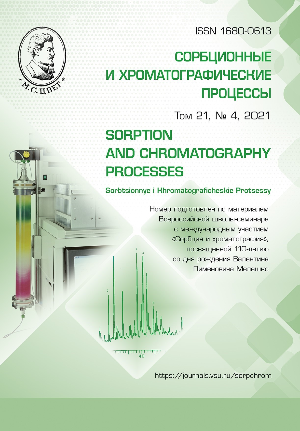Chromatographic behaviour of mono-caffeoylquinic and di-caffeoylquinic acids under the conditions of reversed-phase HPLC: structural dependences
Abstract
The research determined the dependence of the retention of isomeric chlorogenic acids (mono-caffeoylquinic and di-caffeoylquinic) on the position of quinic acid acylation under the conditions of reversed-phase HPLC. We used leaf extracts of Ilex paraguariensis (mate tea) and inflorescences of Cynara scolymus (artichoke buds) with a known composition of chlorogenic acids. It was shown that on separation maps di-caffeoylquinic acids (diCQAs) had trend lines with the characteristic parameter a of the relative retention calculated using the equation lgk(i) = a lgk(caffeic acid) + b . The parameter a for diCQAs was about twice as much as for mono-caffeoylquinic acids (CQAs). Using the value of the parameter a it is possible to detect diCQAs isomers with the additional use of the UV spectrum (which is only characteristic of other extractive substances of a phenolic nature) without mass spectrometric detection. An exception is 1,3-di-caffeoylquinic (1,3diCQA), which demonstrates intramolecular copigmentation due to the stacking interactions of aromatic rings located in closely spaced axial positions in one of the molecular conformations. Such a structure was found as a result of the geometry optimisation by the MM2 method and the Chem3D software. Due to stacking, the simultaneous sorption of 1,3DiCQA by two radicals of caffeic acid was impeded. Therefore, the parameter a had a significantly smaller value (1.674). Intramolecular stacking was confirmed by a change in the electronic absorption spectrum of 1,3diCQA in comparison with the spectra of other chlorogenic acids.
It was shown that in case of di-caffeoylquinic acids, there is a possibility of retention inversions in the series of 3.4diCQA-3.5diCQA-1.5diCQA acids with a change in the composition of the mobile phase. In this case, it is possible to differentiate between these isomers and 4,5diCQA by comparing the parameter a in the equation for the trend line of the relative retention of these acids and mono-caffeoylquinic acids, assuming there are no significant intramolecular structural effects affecting the diCQA retention. The study of the dependence of the diCQAs retention on the pH of mobile phases revealed that it is possible to differentiate acid position isomers by two parameters: by the acidity of the carboxyl group of quinic acid (isomers with acylation at position 1 have higher acidity) and by the degree of decrease in the retention time, which is the highest for isomers with an acyl group at position 5.
Downloads
References
Clifford M.N., Knight S., Kuhnert N. J. Agric. Food Chem., 2005, Vol. 53, pp. 3821-3832. https://doi.org/10.1021/jf050046h
Deineka, V.I., Grigor'ev, A.M. J. Anal. Chem., 2004, Vol. 59, pp. 270-274. https://link.springer.com/article/10.1023/B:JANC.0000018972.54587.ce.
Deineka V.I., Deineka L.A., Saenko I.I. J. Anal. Methods Chem., 2015, Vol. 2015, ID 732918. https://doi.org/10.1155/2015/732918.
Clifford M.N. J. Sci. Food Agric., 2000, Vol. 80, pp. 1033-1042. https://doi.org/10.1002/(SICI)10970010(20000515)80:7<1033::AID-JSFA595>3.0.CO;2-T
IUPAC Commission on the Nomencla-ture of Organic Chemistry (CNOC) and IU-PAC-IUB Commission on Biochemical No-menclature (CBN). Nomenclature of cy-clitols. Recommendations, 1973, Biochem. J., 1976, Vol. 153, pp. 23-31. https://doi.org/10.1042/bj1530023
Clifford M.N., Johnston K.L., Knight S. et al., J. Agric. Food Chem. 2003, Vol. 51, pp. 2900-2911. https://doi.org/10.1021/jf026187q.
de Paula Lima J., Farah A., King B. et al., J. Agric. Food Chem., 2016, Vol. 64, pp. 2361-2370. DOI: 10.1021/acs.jafc.6b00276
Schütz K., Kammerer D., Carle R., Schrieber A. J. Agric. Food Chem. 2004, Vol. 52, pp. 4090-4096. https://doi.org/10.1021/jf049625x
Deineka V.I., Oleinits E.Yu., Blinova I.P. et al., J. Anal. Chem., 2019, Vol. 74, No 8, pp. 778-783. https://link.springer.com/article/10.1134/S1061934819080057
Schoenmakers P.J., Billiet H.A.H., Tijs-sen R. et al., J. Chromatogr. A, 1978, Vol. 149, pp. 519-537. https://doi.org/10.1016/S0021-9673(00)81008-0.
Murugesu K., Saghir S.A.M., Sadikun A. et al., Acta Chromatographica, 2021, Vol. 33, pp. 170-178. https://doi.org/10.1556/1326.2020.00690.
Bicchi C.P., Binello A.E., Pellegrho G.M., et al., J. Agric. Food Chem., 1995, Vol. 43, pp. 1549-1555. https://doi.org/10.1021/jf00054a025.
Ky C.-L., Noirot M., Hamon S. J. Agric. Food Chem., 1997, Vo. 45, pp. 786-790. https://doi.org/10.1021/jf9605254.
Xue M., Shi H., Zhang J., Liu Q.-Q. et al. Molecules, 2016, Vol. 21, 948. https://doi.org/10.3390/molecules21070948
Stalmach A., Mullen W., Nagai C. et al. Braz. J. Plant Physiol., 2006, Vol. 18, pp. 253-262. https://doi.org/10.1590/S1677-04202006000100018







